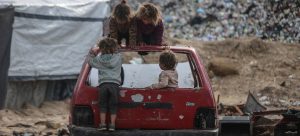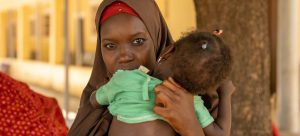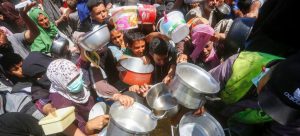
People clamour for food in Gaza. (UNRWA)
Famine conditions are tightening their grip on the Gaza Strip, as the latest UN humanitarian update warns of soaring malnutrition-related deaths, relentless civilian attacks, and mounting obstacles to aid access amid a deepening crisis.
Of the 154 malnutrition-related deaths since October 2023 (including 89 children) reported by Gazan health authorities, the World Health Organisation (WHO) said 63 occurred in July alone.
These deaths follow a steep drop in food consumption: 81% of households reported poor food consumption in July (up from 33% in April), and 24% experienced severe hunger (up from 4%), crossing the famine threshold, according to the humanitarian update issued by the UN Office for the Coordination of Humanitarian Affairs (OCHA) on Wednesday.
Acute malnutrition rates also surpassed famine thresholds in Khan Younis, Deir al Balah and Gaza City.
Given these recent figures, IPC food security experts warned that the worst-case famine scenario is unfolding. However, they added that while the third famine threshold of starvation-related deaths is rising, collecting data remains a challenge.
UN agencies caution that time is running out for a full-scale humanitarian response. 22% of the analysed population is facing a “catastrophic” level of food insecurity, and a further 54% is at an “emergency” level.
At the same time, less than 15% of essential nutrition services remain functional.
Attacks on civilians
Of the over 60,000 Palestinians reported killed since October 2023, nearly 9,000 died after hostilities reignited in March, and 640 between 23 and 30 July.
Civilian casualties while seeking food are also rising, with 1,239 killed and over 8,152 injured since 27 May.
OCHA further noted that displacement figures since 18 March have surpassed 767,800, though no new evacuation orders were issued by Israeli authorities since 20 July. The 20 July order affecting a humanitarian hub in Deir al Balah has since been rescinded.
Amid ongoing displacement, overcrowding in shelters, lack of privacy and worsening hunger have elevated the risk of gender-based violence (GBV) for women and girls.
The conditions are especially dire in southern Gaza, where there are no longer any safe shelters for GBV survivors.
Humanitarian measures
Between 23 and 29 July, only 47% of 92 coordinated aid movements were fully facilitated by Israeli authorities. About 16% were denied, 26% impeded after initial approval, and 11% withdrawn by organisers.
The Israeli military announced a daily 10-hour pause in military activity, beginning 27 July, in Al Mawasi, Deir al Balah and Gaza City “to increase the scale of humanitarian aid entering Gaza.”
They also announced measures including airdrops of flour, sugar and canned food; the reconnection of the power line from Israel to the southern Gaza desalination plant; the removal of customs barriers on food, medicine, and fuel from Egypt; and the designation of secure routes for UN humanitarian convoys.
However, humanitarian partners warned that airdrops could endanger civilians, lead to unequal distribution and fall short of needs.
Limited funding
In addition, a lack of sufficient funding is also hampering response efforts.
As of 30 July, only about 21% of the $4 billion requested for the 2025 urgent humanitarian appeal for the region has been secured, leaving critical gaps.
(This is taken from the United Nations news feed. The original story may be found here.)



